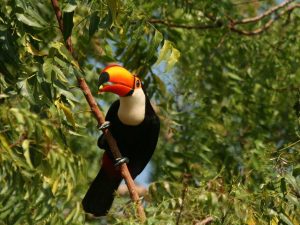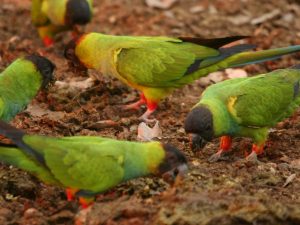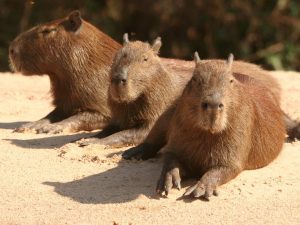
The Pantanal - jaguars, macaws and the world's largest wetland
The Pantanal is a place of superlatives – the world’s largest fresh-water wetlands, ten times the size of the Everglades, covering about 200,000 square kilometers.
Download leaflet
Wildlife Travel leaflet Pantanal 2026
Dates
9th – 25th September 2026
fully booked
Leaders
Price
£7,385
Single Room Supplement – £475
Included
Return flights from London to Brazil. Local transport as specified in itinerary. 14 nights’ accommodation, full board. Entry fees.
Not included
Refreshments. Gratuities. Travel insurance. Covid tests and associated costs.
Group size
Minimum 6, maximum 12.
Pantanal is derived from a Portuguese word meaning ‘swamp’. It is a gently sloping basin with meandering rivers which slowly releases water to a single drainage channel, the Paraguay River. During the dry season, the great wetland shrinks to more manageable pools and channels, and the animals are drawn to these water holes.
The Pantanal is particularly famous as the best place in the world to see South America’s big cat, the Jaguar, and rightly so. We have a good chance of our own encounter with this beautiful predator along the banks of the Cuiaba River near Porto Jofre, where we will be staying on a very pleasant floating hotel. We have a very good chance of finding other notable ‘megafauna’ of the Pantanal including Giant Otter, Giant Anteater, Ocelot and South America’s heaviest animal, the Lowland Tapir, along with various monkeys, deer and foxes, abundant Capybara, Yacaré Caiman and Yellow Anaconda, the world’s largest snake.
We will, of course, be paying plenty of attention to the rich birdlife of the area. Even relaxed birding can yield more than a 100 species a day, and particular highlights will include Hyacinth Macaw, Toco Toucan, Greater Rhea and Red-legged Seriema, alongside plenty of herons and kingfisher, currasows and chachalacas, parrots and woodpeckers.
We will finish our trip to Brazil with some time in the endemic-rich and highly threatened Atlantic Forest, south of Sao Paulo, home to an entirely different suite of tanagers, hummingbirds, antbirds and more.
Download trip report
Please note that holidays change, although sometimes only slightly, from year to year and previous trip reports may not reflect the planned itinerary, or other holiday details, for the current trip. Please ask us if you would like to know of any significant differences.
Day 1 Our evening flight takes us to São Paulo early on Day 2.
Day 2 We transfer to our internal flight heading 1,000 km inland to the state of Mato Grosso and the city of Campo Grande. We head out to explore the countryside surrounding the city and our first taste of Brazilian bird life, with Curl-crested Jay, Yellow-faced Parrot and Aplomado Falcon all likely.
Day 3-5 We travel westwards to our lodge, set on an island between two branches of the Salobra River, as it forms a delta watering the southern Pantanal. With just eight rooms, the lodge offers high quality accommodation with a touch of style. We will have a relaxed three days to explore the Salobra delta, and familiarise ourselves with the wildlife of the southern Pantanal. We will no doubt encounter one of the iconic birds of the Pantanal: South America’s largest parrot, the Hyacinth Macaw is a common sight. Inquisitive Nanday Parakeets and comical Black-bellied Whistling Ducks also visit the gardens, while additional flashes of colour are produced by Orange-backed Troupial and Chopi Blackbird, Turquoise-fronted Amazon and Blue-and-Yellow Macaws. We will no doubt make more than one excursion by boat, out onto the quiet waterways and backwaters of the delta, in the company of Black-collared Hawk and Roseate Spoonbill, Wood Stork and the enormous Jabiru. Monkeys in the area include Black-and-Gold Howler Monkey and Hooded Capuchin, while we should encounter plenty of Yacare Caiman, the common crocodile of the region. Two species of otter and four species of kingfisher make their home on these waterways, along with a variety of herons, including the beautiful Agami Heron, while more than ten species of parrot are found in the area, and will provide noisy entertainment for us. Away from the wetlands, we will venture out onto the surrounding campo to look for some of the characteristic animals of the drier plains: Greater Rhea, Red-legged Seriema, South American Coati, Pampas Deer and the bizarre Giant Anteater will all be on our ‘wish list’, and we hope to have some close-up encounters with these wonderful characters. After dinner we will head out on a night excursion to search for some of the nocturnal inhabitants of the area: Crab-eating Fox, Brazilian Cavy and the elegant Marsh Deer may all show up in our spotlights, as well as various night birds, but our fingers will be firmly crossed that we stumble across one of the region’s stars: Ocelot, Puma or even Maned Wolf are all possibilities, if our luck is really in.
Day 6 Depending on flight times, we may take one more excursion into the Refugio’s private reserve. From here, we will set off for the drive back to Campo Grande, arriving in time to catch a domestic flight some 550km north, to Cuiaba.
Day 7 This morning we head south to Pocone, the gateway to the northern Pantanal. Here we set off on the famous ‘Transpantaneira’ that takes us deep into the Pantanal. Today we are heading just 45km south to the Pousada Rio Claro, set on the banks of the Rio Claro. The surrounding area has several lagoons and water holes, and we may head to one of these as the day comes to an end. As the heat of the day fades away, the animals come out to drink, and we will be keeping our fingers crossed that one animal in particular, the Lowland Tapir pays us a visit.
Day 8 Trails leading out from the lodge into the surroundings offer the chance to see Black-tailed Marmoset, Southern Tamandua and many of the birds of the northern Pantanal. After our morning’s explorations, we will head deeper into the Pantanal, strking out along the Transpantaneira. While we will be stopping along the way to enjoy the huge numbers of wetland birds and whatever mammals we may come across, we will no doubt all be eager to arrive at our destination, Porto Jofre, and our floating hotel, home for the next three nights.
Days 9 and 10 We spend two busy days on the Cuiaba River focussing on the South American ’king of the jungle’, the mighty Jaguar. The Pantanal is home to one of the densest populations in all of the Americas, and the banks of the Cuiaba River and its many side streams have become famous as the best place in the world to see this apex predator. Jaguar here feed on Capybara and Yacare Caiman, both of which will be a common sight during our boat trips. We spend our days exploring quiet side channels, scanning the river banks and sand bars where the cats hunt, rest and socialise. The same waterways are home to several families of Giant Otters, and we can expect to be distracted from our big cat hunt by these equally-impressive animals. At night, large Fishing Bats skim the water beside our ’flotel’ while the calls of night birds echo from the forested riverbanks.
Day 11 We may have one last early morning boat trip out onto the ‘three brothers’, before it is time to bid farewell to the river and to Porto Jofre. Back on dry land, we have a long drive ahead, as we travel back up the Transpantaneira, stopping at the roadside wherever we find concentrations of birds and hoping to find Yellow Anaconda, the world’s largest snake somewhere along the way. Our last night on the Pantanal will be spent at the Fazenda Santa Tereza, on the banks of the Rio Pixaim.
Day 12 Our ecolodge is set on 3,500 hectares of floodplain habitat along the banks of the river. We may visit one of the area’s canopy towers, take a boat trip on the river, or other opportunities for wildlife watching around the lodge: amongst the animals we will be looking out for will be Black-and-Gold Howler Monkeys or Bearded Capuchins, and the area is famously home to a high density of the beautifully spotted Ocelot.
Day 13 After one last early morning bird walk, we head back to the city of Cuibaba and our flights to São Paulo. From Guarulhos, we head west into the lush Mata Atlãntica, the Atlantic Forest that stretches from northern Brazil down into the northern corner of Argentina.
Days 14 and 15 Once the second largest rainforest on the planet and characterised by high levels of endemism (40% of its vascular plants and 60% of its vertebrates are found nowhere else, including over 140 species of endemic birds), over 85% of the original Mata Atlãntica has been deforested, making this one of the world’s most endangered biomes. We will spend the next three days exploring the various habitats within striking distance of our lodge, enjoying the diversity of hummingbirds and tanagers, woodpeckers and parakeets, cotingas, manakins and more.
Day 16 After another day of birding the Atlantic Forest, we make our way back to São Paulo and the airport for our flights home, arriving Day 17.
Please note that the itinerary may be changed to suit the weather or other practicalities at the discretion of the leaders.
All of the lodges and hotels are of a good standard, some with very attractive settings. In Porto Jofre we will be staying in a floating hotel. All the rooms have private bathrooms with hot water and are either air-conditioned or have ceiling fans where needed. Some lodges may have a swimming pool available. Single rooms are available in all locations. The exact lodge or hotel used may be changed if local conditions change or if we feel a different choice would suit our needs better.
All meals are included – some lunches will be in local restaurants, and we will take a picnic on some days.
We will do our best to ensure that our travelling is as comfortable as possible. There will be days when we are transferring from one area to another where the journey may take much of the day but we will take plenty of stops for comfort breaks and to enjoy interesting areas. Some excursions will be by 4X4 vehicles or open top truck: we will also be taking several boat trips, notably during our time on the Rio Cuiaba, when we will be looking for Jaguars.
Group flights
Group flights are with LATAM from London Heathrow. 2026 flight times aren’t yet available, but are likely to be similar to 2025 times.
9th September depart London Heathrow 21.20, arrive São Paulo (Guarulhos) 05.00 (10th)
10th September depart São Paulo (Guarulhos) 09.25, arrive Campo Grande 10.15
24th September depart São Paulo (Guarulhos) 23.45, arrive London Heathrow 15.05 (25th)
Internal flights are scheduled flights with LATAM or AZUL.
Time zone
The Pantanal is three hours behind UK time, São Paulo is two hours behind UK time.
Entry requirements
If you hold a British passport you do not need a visa to enter Brazil for up to 90 days for tourism. Your passport must have an expiry date at least six months after the date you arrive.
The Pantanal is fantastic year-round, but cyclical water levels mean that wildlife watching varies considerably with the season.
The height of the rainy season is between December and March, when temperatures also reach their peak: during the wet season, dry land becomes the scarce resource, and mammals congregate on raised areas.
We will be visiting at the end of the dry season, when temperatures are at their most pleasant, travel on the Transpantaneira is simplest, colourful flowering trees are in full bloom, and the wildlife is concentrated around the dwindling water sources. Jaguar sightings on the ‘three brothers’ rivers peak in September.
The days will be warm, with expected temperatures between 20° and 30°C and (hopefully) dry, although there is always the chance of some early rains. Evenings will be cooler.
There is a very low risk of malaria in the parts of Brazil we visit, and prophylaxis isn’t usually recommended. There is a risk of Yellow Fever in the parts of Brazil we visit, and vaccination is recommended for most travellers. Vaccines against Hepatitis A, Tetanus and Typhoids are recommended for most travellers, and you might also want to consider Hepatitis B, Tuberculosis and Rabies vaccines.
Up-to-date information on travel health can be found at travelhealthpro.org.uk. You should consult your travel clinic for current advice on travel health, at least eight weeks before the trip.








